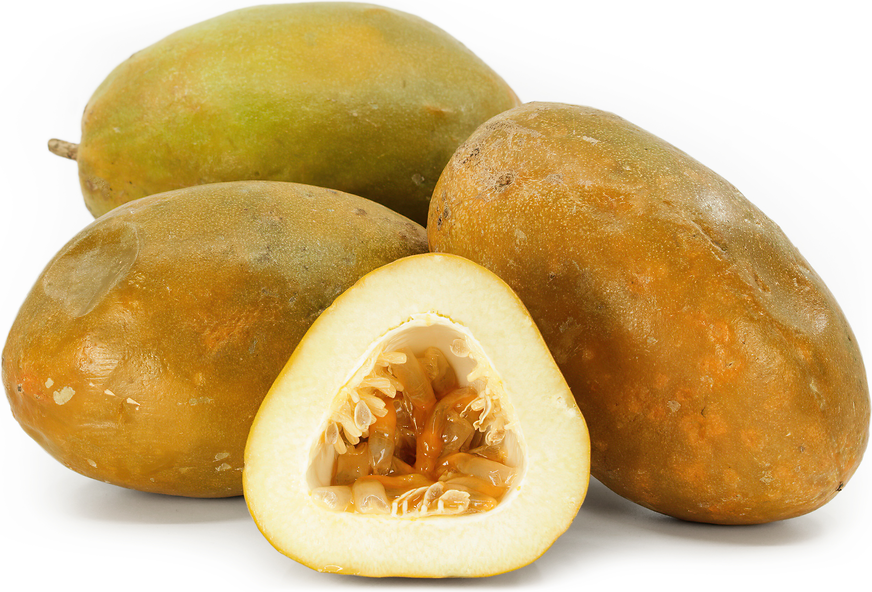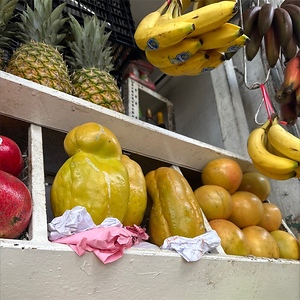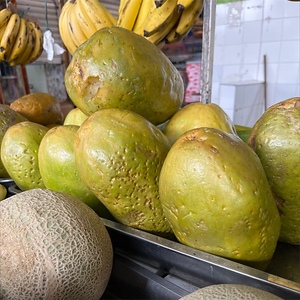


Giant Tumbo Passionfruit
Estimated Inventory, lb : 0
Description/Taste
Giant Tumbo passionfruits are medium to large in size, averaging 10 and 30 centimeters in length and 12 to 15 centimeters in diameter, and have an oval to oblong shape with blunt, curved ends. The fruits range from 1.5 to 4 kilograms in weight and have thin, delicate, waxy, and smooth skin, appearing in shades of golden yellow-orange, yellow, to pale green-yellow, depending on the growing environment. The skin may also be faintly ribbed and blushed with pink. Underneath the surface, a thick layer of flesh surrounds a cavity filled with pulp and seeds. The ivory-to-pink flesh is 2 to 4 centimeters in diameter and has a mealy, spongy, and soft consistency. The aqueous, gelatinous pulp varies in color from orange, yellow, to translucent and envelops small, black-brown seeds less than 1 to 2 centimeters in length. The flat, oval seeds provide a crunchy texture, while the slippery pulp adds contrast to create a complex mouthfeel. Giant Tumbo passionfruits are aromatic and have a mild, sweet, and subtly sour taste with pear, peach, and melon nuances. The fruit's sourness is lower than other passionfruit species, and the flavor is mellower than common, smaller varieties sold commercially.
Seasons/Availability
Giant Tumbo passionfruits are available year-round in tropical regions.
Current Facts
Giant Tumbo passionfruit, botanically classified as Passiflora quadrangularis, is a tropical species belonging to the Passifloraceae family. The fruits develop on fast-growing, evergreen climbing vines extending over 10 to 15 meters in length, and some vines, depending on the region they are grown in, can be much longer. Giant Tumbo passionfruit is the largest fruiting species within the genus Passiflora and is known by several names, including Barbadine, Parcha, Badea, Grenadine, and Giant Granadilla. It is important to note that Giant Tumbo is sometimes confused with Banana passionfruit, Passiflora mollissima. This species is occasionally referred to as Tumbo in South and Central America, creating confusion. Giant Tumbo passionfruit are much larger in size, earning the species its "giant" moniker. Giant Tumbo passionfruits ripen in 65 to 85 days, and the fruits can be left on the vine for several weeks. The species is distinct from other passionfruits as the fruit's pulp, seeds, and flesh are edible. Giant Tumbo passionfruits have a thick flesh that is prepared like a vegetable, and in most other passionfruit species, the flesh is thin and not consumed. In the modern day, Giant Tumbo passionfruits are not commercially produced and are only grown on a small scale for sale in local markets. The fruits are also planted and hand-pollinated in home gardens and are utilized in fresh and cooked culinary preparations.
Nutritional Value
Giant Tumbo passionfruits are a source of vitamin A to maintain healthy organ functioning, vitamin C to strengthen the immune system, and potassium to balance fluid levels within the body. The fruits also provide fiber to regulate the digestive tract, calcium to build strong bones and teeth, iron to develop the protein hemoglobin for oxygen transport through the bloodstream, and other nutrients, including phosphorus, niacin, and riboflavin. In Brazil, Giant Tumbo passionfruits are incorporated into natural medicines to relieve symptoms associated with stomach ailments, headaches, and insomnia. The fruits were also historically used to combat scurvy and low anxiety levels.
Applications
Giant Tumbo passionfruits have a sweet and subtly tangy taste suited for fresh and cooked preparations. The fruits are typically cut in half, and the pulp and seeds are scooped from the flesh as a refreshing snack. The pulp and the seeds are the most used portion of the fruits, but the thick, spongy flesh can also be utilized raw or cooked. The flesh of young fruits is traditionally prepared like a vegetable, steamed, boiled, or sauteed with spices and other flavorings. The flesh can be simmered into soups, curries, and stews or breaded and fried with spices. Ripe fruit flesh can be sliced and mixed with other fruits and lemon juice as a fresh dish, or the flesh can be cooked in sugar as a candied treat. In addition to the flesh, the pulp and arils are added to ice cream, pie fillings, cake batters, and cream-based mixtures. The pulp can also be simmered into jellies, blended into smoothies, strained into juices, or fermented into wine. In Southeast Asia, the pulp is popularly combined with sugar and topped over shaved ice. Giant Tumbo passionfruits pair well with fruits such as coconuts, oranges, papayas, kiwis, bananas, and mangos, spices including nutmeg, anise, and cinnamon, vanilla, basil, mint, and nuts such as almonds and cashews. Whole, unopened Giant Tumbo passionfruits should be immediately consumed when ripe for the best quality and flavor and will keep up to five days at room temperature. Once opened, the flesh, pulp, and seeds should be stored in the refrigerator. The pulp and flesh can also be frozen for up to six months.
Ethnic/Cultural Info
In South America, Giant Tumbo fruits are also known as Giant Granadilla, a name given by the Spanish. In the late 16th century, Spanish explorers encountered the fruits and compared them to the pomegranate, a familiar fruit in Spain. Pomegranate in Spanish translates to Granada, and the South American fruits were named Granadilla after their similarity in coloring to specific varieties of pomegranates. The species' botanical genus, Passiflora, is derived from the Latin for "passio," meaning "passion," and "flos," meaning "flower." The species epithet, or descriptive phrase, quadrangularis, was given to the plants for their four-angled stems. Quadrangularis means "four angles."
Geography/History
Giant Tumbo passionfruits are native to tropical regions of South America. Much of the species' history is unknown, but experts believe the fruits may have originated in the humid, warm forests of Brazil and were spread to other tropical regions throughout South and Central America and the Caribbean. Giant Tumbo passionfruits easily naturalized into regions as they expanded across the continents, and Spanish explorers noted the species in the 16th century, introducing the plant to Europe and later Asia. Cultivation of the species began sometime around the 18th century, and in 1815, Giant Tumbo passionfruits were listed in “The Botanical Register,” written by Sydenham Teast Edwards, and were recorded as an item grown in greenhouses in Europe and throughout the West Indies. Today Giant Tumbo passionfruit vines thrive in lowland tropical forests worldwide and climb over trees, fences, and lowland vegetation. The species is harvested from wild plants and is also grown on a small scale in home gardens in South America, Central America, the Caribbean, Southern Mexico, Southeast Asia, India, Sri Lanka, Australia, and tropical Africa. Giant Tumbo passionfruits can also occasionally be seen in gardens in South Florida and Hawaii.









